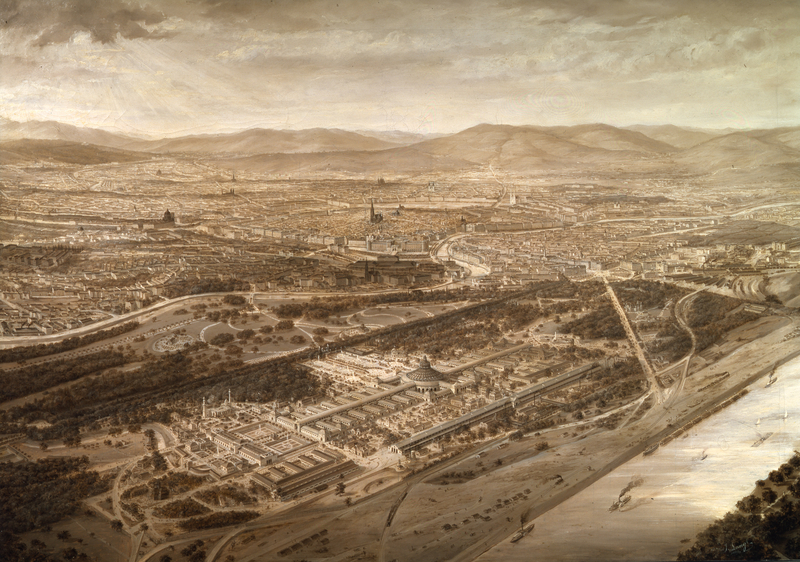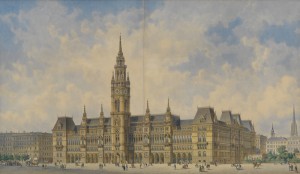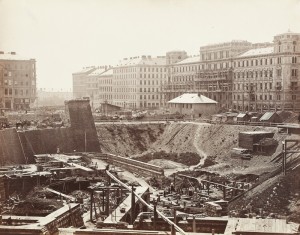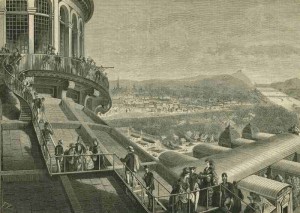Wien Museum: The 1873 Metropolis Experiment: Vienna and the World Exhibition

If you don’t feel like sitting lazily at home or as a guest in a hotel on a rainy summer day in Vienna, you have many alternatives, among them the numerous appealing museums for every area of interest. One of my favorite museums is the “Wien Museum,” because in my opinion the exhibitions about Vienna effectively reflect the view of society of the respective epochs. This is also the case for the current exhibition, which I wish to warmly recommend to Viennese and visitors to Vienna alike.

Friedrich-von-Schmidt-Winners draft of the new City hall Vienna-1869-Aquarellierte-Federzeichnung-©-Wien-Museum
Metropolis experiment
1873: Vienna and the World Exhibition
The current exhibition at the Wien Museum is about the era around 1873, a decisive phase of upheaval in Vienna on its way to becoming a major metropolis. 1873 was a turning point, as it was the year Vienna hosted the gigantic World Exhibition, with which Vienna was to gain in international significance; it was to represent Vienna’s economic boom and its advancing industrialization.
Around 1850, Vienna had 550,000 residents, and 20 years later it was over one million. The so-called Gründerzeit (“Founders’ Epoch”) was one of the most eventful epochs that Vienna has ever undergone. There were innovations in the cityscape, in the modernization of its infrastructure, as well as in culture and lifestyle that changed Vienna significantly and continue to characterize the city to the present day. This development was promoted by the independently wealthy, property-owning bourgeoisie.
Gigantic changes
After the city walls were demolished, Vienna was radically rebuilt starting in the 1860s. The “new” Vienna along the Ringstrasse, with its public buildings and the palaces of the “money barons” displayed a metropolitan appearance and a society undergoing radical change. This took place in architecture just as it did in the luxurious projects and objects of the art industry.
In 1873, construction of the mountain spring water pipes was completed, with which provision of healthy water could be secured – a “must” in the rapidly growing yet hygienically antiquated city. An additional major project was regulation of the Danube River: for seven years, the new, dead-straight river bed was dug. The new Zentralfriedhof (Central Cemetery) also arose during that era.
The comprehensive constructions led to a spatial and social secession between center and periphery. Mass immigration and the increase in working persons in the growing industry generated housing shortages, poverty and hardship. Around 1870, necessary housing construction therefore commenced in the outer districts.
The central topic of the show is the World Exhibition. It was the first one that did not take place in London or Paris, and the largest one up to that time. Giant constructions such as the 905 meter long Industriehalle and the 85 meter tall Rotunde, which was intended as a new emblem, were located on the exhibition space in the Prater. 7 million visitors came to Vienna for the World Exhibition in 1873, yet there was still a bitter aftertaste: After the opening the stock market crashed, marking the end of the economic boom, and a major crisis followed.
The exhibition is also dedicated to special topics in the Gründerzeit, such as mass entertainment and the addiction to exotic goods, and it casts its gaze at fashion and living culture, medicine and technology, and thus explains the origin of many areas that exist to the present day.
Moreover, the Wien Museum is always an interesting venue with its “side exhibits”; the plethora of literature and catalogs (also on past exhibitions) are a further incentive to spend an afternoon here.
Info and details:
The Metropolis Experiment –
1873: Vienna and the World Exhibition
until through September 28, 2014
1040 Vienna, Karlsplatz 8
T: +43 (0)1 505 87 47 0,
Admission charges
Adults € 8.00
Senior citizens, Wien-Karte holders, Ö1-Club members, disabled persons, students up to 27 years of age, trainees, military recruits and civil servants, groups of 10 or more persons € 6.00
For children and youth under 19 years of age: free admission!
Free admission every first Sunday of the month for all visitors!
Tip:
Wien Museum and many more of Vienna’s landmarks are only a stone’s throw from the centrally located Schick Hotels Wien. Discover the Austrian capital on foot and via public transportation!
Image sources: © 2014 Wien Museum












